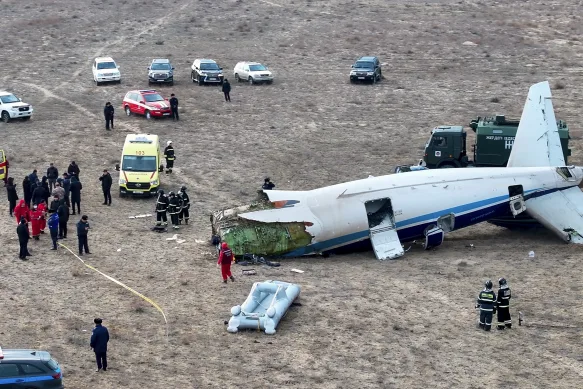Moscow — A tragic plane crash involving an Azerbaijani airliner has occurred in Aktau, Kazakhstan, with Kazakhstan’s Emergency Ministry confirming that 28 individuals survived. The crash raises concerns that more than 30 people may have perished.
Confirmed Casualties and Survivors
The Kazakhstan Emergency Ministry stated on Wednesday that 67 people, including five crew members, were aboard the Embraer 190 aircraft. Initial reports confirmed 25 survivors, a figure later revised to 27 and subsequently 28 as search and rescue teams worked tirelessly at the crash site. Tragically, four bodies have already been recovered. Survivors are currently receiving medical treatment at local hospitals.
Despite the growing count of survivors, the death toll is anticipated to exceed 30. Russian news agency Interfax also reported that additional survivors could still be located as search operations continue.
Emergency Landing and Initial Details
The Embraer 190, operated by Azerbaijan Airlines, was originally scheduled to travel from Baku, Azerbaijan’s capital, to Grozny, a city in Russia’s North Caucasus. The aircraft encountered an emergency situation due to a suspected bird strike, prompting the pilot to divert and attempt an emergency landing approximately 3 kilometers from Aktau.
According to preliminary information provided by Russia’s Federal Air Transport Agency, the bird strike caused significant complications during the flight, leading to the fatal descent.
Eyewitness Footage and Plane Crash Analysis
Mobile phone videos shared widely on social media depict the aircraft making a sharp descent before erupting in flames upon impact. The fiery crash left debris scattered across a grassy field, with portions of the fuselage torn from the wings and the main body of the aircraft lying upside down.
The footage aligns with the plane’s distinct colors and its official registration number, further corroborating the catastrophic event.
Flight Data and Technical Challenges
Data from FlightRadar24.com reveals irregular flight patterns in the moments leading up to the plane crash. The aircraft reportedly performed erratic altitude shifts and made what appeared to be a figure-eight maneuver as it approached Aktau Airport. These irregularities suggest severe challenges in navigation and control.
FlightRadar24 also highlighted issues related to “strong GPS jamming,” which impacted the aircraft’s ability to transmit accurate ADS-B data—critical information used for real-time flight tracking. Experts have pointed out that GPS interference has previously been attributed to activities in the region, raising further questions about the crash.
Rescue Operations and Immediate Response
Kazakhstan’s Emergency Ministry is actively coordinating rescue efforts at the crash site. Search teams continue to comb through the wreckage, hoping to locate additional survivors or recover remains. The fluctuating survivor count underscores the dynamic and challenging nature of rescue operations in such devastating circumstances.
Reactions from Aviation Authorities and Airlines
Azerbaijan Airlines confirmed the crash and emphasized its commitment to keeping the public informed as more details emerge. The airline has changed its social media banners to solid black as a sign of mourning. Meanwhile, Embraer, the manufacturer of the aircraft, has yet to issue an official statement.
A spokesperson for Russia’s Federal Air Transport Agency confirmed ongoing investigations into the bird strike incident and its cascading effects on the flight’s safety. Additional scrutiny will likely examine the GPS jamming issues reported by FlightRadar24.
Broader Implications and Safety Concerns
The plane crash raises significant concerns regarding aviation safety, particularly in regions prone to GPS interference. Experts have long warned about the risks posed by jamming signals to aircraft navigation systems. This incident highlights the urgency of addressing such vulnerabilities, especially in geopolitically sensitive areas.
Additionally, the Embraer 190’s performance and safety protocols will be reviewed to identify potential design or operational flaws. Bird strikes remain a common hazard in aviation, but their impact can vary widely based on aircraft design, pilot response, and external conditions.
Also Read: CapCut vs Filmora
Global Reactions and Support
The international aviation community has expressed condolences for the victims and their families. Airlines and regulators worldwide are monitoring the situation closely, awaiting detailed findings from the investigation. The tragedy has reignited discussions about enhancing aviation safety measures, particularly in addressing GPS interference and bird strike mitigation strategies.
What’s Next?
As the investigation unfolds, Kazakhstan’s Emergency Ministry, Azerbaijan Airlines, and international aviation authorities will collaborate to determine the exact causes of the crash. The focus will be on preventing similar incidents in the future through improved safety protocols and technology.
Azerbaijan Airlines has assured the public that updates will be provided promptly. For now, the world mourns the loss of lives in this devastating accident, while hoping for clarity and accountability in its aftermath.

